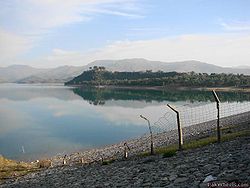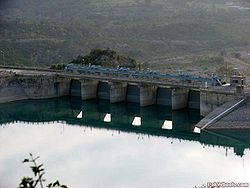
Khanpur Dam
Encyclopedia


Haro River
Haro is the name of a river and its valley in Abbottabad District in the North West Frontier Province of northern Pakistan, identified with the Rigvedic Arjikiya...
near the town of Khanpur, Khyber Pakhtunkhwa (formerly NWFP), Pakistan
Pakistan
Pakistan , officially the Islamic Republic of Pakistan is a sovereign state in South Asia. It has a coastline along the Arabian Sea and the Gulf of Oman in the south and is bordered by Afghanistan and Iran in the west, India in the east and China in the far northeast. In the north, Tajikistan...
, about 25 miles (40 km) from Islamabad
Islamabad
Islamabad is the capital of Pakistan and the tenth largest city in the country. Located within the Islamabad Capital Territory , the population of the city has grown from 100,000 in 1951 to 1.7 million in 2011...
, Pakistan
Pakistan
Pakistan , officially the Islamic Republic of Pakistan is a sovereign state in South Asia. It has a coastline along the Arabian Sea and the Gulf of Oman in the south and is bordered by Afghanistan and Iran in the west, India in the east and China in the far northeast. In the north, Tajikistan...
. It forms Khanpur Lake, a reservoir which supplies drinking water to Islamabad and Rawalpindi and irrigation water to many of the agricultural and industrial areas surrounding the cities.
The dam was completed in 1983 after a 15-year construction period believed to have cost Rs. 1,352 million. It is 167 feet (51 m) high and stores 110000 acre.ft of water.
The adjoining Khanpur Lake is the venue for Sarhad Tourism Corporation
Sarhad Tourism Corporation
Sarhad Tourism Corporation set up as a limited company in 1991 to develop Khyber-Pakhtunkhwa's tourism potential.It offers a variety of services in key tourist sites in Khyber-Pakhtunkhwa, as well as visits to attend the Shandur Festival as well as to famous Buddhist monasteries like Takht Bhai and...
's annual airborne and waterborne sports gala. The event, termed as the 'biggest' in Pakistan was scheduled to take place between 9 and 11 April 2010.
History
The dam was built by Ayub Khan, former President of PakistanPresident of Pakistan
The President of Pakistan is the head of state, as well as figurehead, of the Islamic Republic of Pakistan. Recently passed an XVIII Amendment , Pakistan has a parliamentary democratic system of government. According to the Constitution, the President is chosen by the Electoral College to serve a...
. The dam was believed by many to be a way for Khan to settle political scores with the feudal chief of Gakhars Raja Erij Zaman.
The forefathers of local Gakhars
Gakhars
The Gakhars are an ancient warrior clan who have predominantly resided in what is present day northern Punjab and South-Western Kashmir, Pakistan. In particular in the cities of Rawalpindi, Jhelum and regions of Gilgit, Baltistan, Chitral, Khanpur and Mirpur, Pakistan...
Rajas were given much of the local land by the British during the nineteenth century. The British rewarded the Gakhhars for their cooperation in defeating the Sikhs, but deprived the local Awan and other farmers of their land. When the decision to build Khanpur Dam was made, the Rajas wanted to receive compensation for all the land, thus depriving all the local inhabitants of their land rights. The residents desperately wanted to receive compensation or new land in the nearby New Khanpur.
The local community, led by Abdul Bashir Khan (the father of Saeed Khan
Saeed Khan
Saeed Khan, is a renowned contemporary Urdu poet , a Sydney based writer and a well known social and environmental advocate. Saeed's poetry is a combination of classical and modern Urdu ghazal and poems full of romance. Saeed’s idol and the great Urdu Poet Ahmad Faraz praised his poetry by...
), the young secretary of Khanpur’s WAPDA Union in the early 1970s, took on the Ghakhars and their friends in the Khyber Pakhtoon Khoa parliament. Amid threats and intimidation, the campaign succeeded in uniting most local villagers, who had nothing but their land. Abdul Bashir and his fellow activists decided to take their campaign straight to then NWFP governor Hayat Sherpao by camping outside the governor's house for days. Abdul Bashir and his fellow activists left Peshawar
Peshawar
Peshawar is the capital of Khyber-Pakhtunkhwa and the administrative center and central economic hub for the Federally Administered Tribal Areas of Pakistan....
only after they had succeeded in winning the land rights for the people of Khanpur.
The locals were promised free water and electricity by WAPDA and the then provincial and federal governments, but are still waiting to this day.
Pictures of Khanpur Dam
- PakWheels.com
- http://www.orkut.com/AlbumZoom.aspx?uid=14427395318334776151&http://www.orkut.com/Album.aspx?uid=14427395318334776151&aid=1pid=9&aid=1#pid=9
- http://www.facebook.com/album.php?aid=162316&id=600139437

